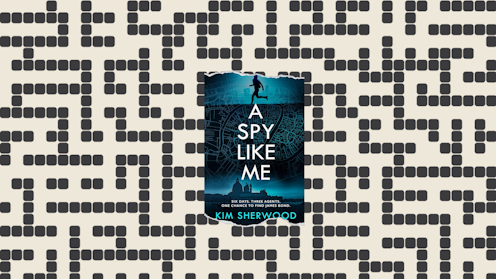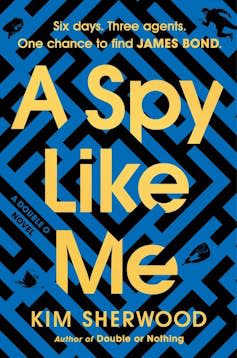A Spy Like Me: Kim Sherwood’s evocative and thrilling addition to the James Bond canon

This article contains spoilers for The Double O trilogy of James Bond books by Kim Sherwood
In the first book of Kim Sherwood’s Double O trilogy, Double or Nothing (2022), James Bond has gone missing. No one knows what’s become of him, but Moneypenny, now in charge of the Double O Section of the British Secret Intelligence Service, has not given up hope.
Enter MI6’s “new blood”, a new generation of 00 agents tasked with retrieving Britain’s greatest spy. They include agent 003, Johanna Harwood, named after the Bond film franchise’s first female scriptwriter, and 004, Joseph Dryden, the “freakish human-machine hybrid” permanently connected, via a surgical implant, to MI6. Scientists Aisha Asante and Ibrahim Suleiman now operate “Q”, the sophisticated machine that has replaced the geeky technology experts of previous Bond stories.
James Bond is still missing at the start of A Spy Like Me (2024), so the team are back to solve the mystery behind his disappearance. The story unfolds, as typical of Bond stories, across the world, encompassing exotic glamour (Oman, Venice, Dubai), dangerous hotspots (Afghanistan, Iran, Russia) and the thrill of adventure (Crete, Australia, Altai Republic).
The action kicks off with a terrorist attack on the BBC’s headquarters in central London, a blow to the heart of a British institution and, by extension, the nation. While the episode is one in a series of seemingly unrelated events that have recently shaken up global security, the time pattern identified by Q’s analysis – each six days after a large financial transaction – connects this attack with a recent sale at Sotheby’s auction house.
Time is ticking for the multiple agents – including new agent 000 – involved in parallel missions to link a network of international smugglers to Rattenfänger, the paramilitary organisation suspected of holding James Bond hostage.
Women and the dark side of globalisation
An engrossing thriller, A Spy Like Me gifts its readers with a diverse range of complex female characters, an important enhancement Sherwood delivers to the Bond canon.
Many smart, brave and dangerous women operate at the centre and on the peripheries of the story. Rachel Wolff is a nimble thief and safe cracker who becomes MI6’s latest recruit. Lisle Baum, who started off in Ian Fleming’s short story Risico as “mistress to criminals who dealt in everything from drugs to women”, is back as an apparently more empowered “jewellery empress”.
It is, however, Moneypenny’s fiercely cold intelligence that pulls the strings of this complex counter-terrorist operation, which, in its disregard of protocol, bears the trademark maverick style of the missing James Bond.

The team fight to identify the transnational smuggling top figures, named after the double-faced Roman god Janus. Rather than branding them as quintessential villains, their duplicity gestures to the dubious “00” itself, a licence to kill that conveniently turns the victim of murder into “collateral damage”.
Moral dilemmas keep haunting Harwood, who is intensely aware of “what it means to be a spy like her – her own double heart, her own double life, in grief and the waking world, in love with two men, an untaken path as a doctor and a half-life as a spy.”
Readers will remain tantalised by the oscillating needles in the agents’ moral compasses: “It’s the people we trust, without compromise, that compromise us”, Moneypenny inevitably admits at the end.
A spy like Kim
Sherwood’s captivating story is self-consciously festooned with literary references to Fleming’s most memorable characters and stories. Among others, Bond’s father-in-law, Marc-Ange Draco (On Her Majesty’s Secret Service, 1963), and Tiger Tanaka, chief of the Japanese Secret Services (You Only Live Twice, 1964), both come to Dryden’s assistance.
The novel’s literary playfulness does not stop at cross-references to the Bond literary and cinematic canons. It unapologetically erodes the boundaries of genre, smashing the wall that, even according to Fleming, sets thrillers apart from “literature”. In fact, it does more than that.
Though not as concise as Fleming’s, Sherwood’s prose is evocative in its own distinctive ways. In a scene describing a villain’s sinister hospitality (a formula made popular by the film adaptation of Dr No), dinner becomes “a silent affair, stretched over a polished steel table as long as a limousine … like eating on a mortician’s slab”.
Elsewhere, Sherwood goes, arguably, even further than Fleming in deploying forensic detail to expose the fragile geology of the human body and identify the fault lines of an unknown story: “One’s experiences are imprinted on the brain and the heart, and the gut and the joints, just like eras imprinted on ice,” Harwood notes when confronted with the corpse of someone she used to know.
The novel’s wealth of detail is a credit to Sherwood’s efforts both as a researcher invested in learning the facts behind her labyrinthine plot, and as a writer whose ears always perk up to the intriguing stories around her.
Writing is, in fact, not too dissimilar from spywork. At one point in the story, seeking to link the financial transactions and photographs of trafficked women stored in a villain’s laptop, “Harwood gazes at the wall, not seeing the sheer concrete, but instead, seeing a story.” In this epiphany, the code is cracked, the plot is found, the story is revealed. The spy is the writer. The writer is the spy.
This article is republished from The Conversation under a Creative Commons license. Read the original article.

Monica Germanà does not work for, consult, own shares in or receive funding from any company or organisation that would benefit from this article, and has disclosed no relevant affiliations beyond their academic appointment.

 Yahoo News
Yahoo News 